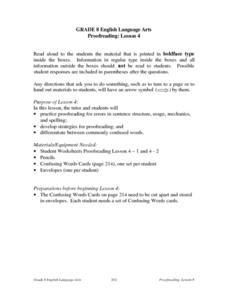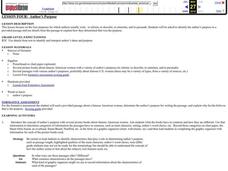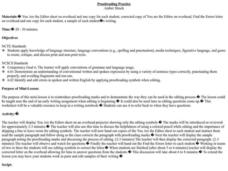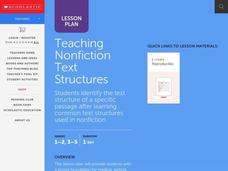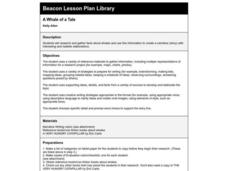Curated OER
Descriptive Writing-The Hobbit
Young readers write a descriptive paper on the fantasy characters in The Hobbit. They take notes as they read the novel in order to provide descriptions of the character traits of hobbits, dwarfs, trolls, wizards, and goblins. They...
Curated OER
Formal versus Informal Language
Engage in an activity that focuses on the concepts of formal and informal language use. Middle and high schoolers compare and contrast each style by using a Venn diagram that includes some examples. They read and hear a passage of lyrics...
Curated OER
Transcendentalism and Epiphany in Ray Bradbury's Dandelion Wine
Twelfth graders examine the characteristics of transcendentalism. In this transcendentalism instructional activity, 12th graders determine what this type of writing entails before reading a passage from, Ray Bradbury's, Dandelion Wine....
Curated OER
Why Do Authors Write?
Sixth graders use short reading passages to identify, explain, and discuss the author's purpose for writing. After a lecture/demo, they utilize a graphic organizer embedded in this plan to organize their writing ideas.
Curated OER
Autobiographical Writing
In this unique lesson on autobiographical writing, students compare and contrast three types of writing: narrative, poetry and newspaper. Students prepare to produce a short autobiographical writing based on the framework of one of the...
Curated OER
Proofreading: Lesson 4
Examine the key strategies to proofreading a piece of writing for errors in sentence structure, usage, mechanics and spelling. Eighth graders practice putting into correct passage commonly confused words (too, two, to) when writing to a...
Curated OER
The Human Body: Five Types of Human Cells
Students explore the human body by completing a graphic organizer. In this living cells lesson, students analyze a human body cell's chart and discuss the parts of a cell and what they do for our bodies. Students complete a graphic...
Curated OER
Author's Purpose
Readers identify the author's purpose. First, they read a passage and utilize details from the piece to determine the author's purpose. Then they will explain how they arrived at their conclusion. Links to materials are provided.
Curated OER
Autobiographical Writing
Second graders explore, examine and study the style of autobiographical writing and the relationship with the author. They rad three different types of autobiographical writings: narrative, poetry and newspaper article. Each student...
Curated OER
Fahrenheit 451: Social Criticism
Students write a four paragraph essay that tells about two things in society that Ray Bradbury criticizes in the book, Fahrenheit 451. In this social criticism lesson, students develop a thesis based on their reading of the book and...
Curated OER
Can You Get the Signal?
What is a signal word? Recognizing these words is an important step in both reading and writing formal text. Review a list of signal words (provided and organized into specific categories), and then have your class play a game to...
Curated OER
Members of Congress Who Have Made a Significant Contribution
Students examine laws that have benefited the nation in a variety of ways. The congressperson in the legislative branch of the government primarily responsible for the passage of the law and the current representatives are sought in this...
Curated OER
Small Group Reading
It's the age of technology! The idea of computer literacy and fluency are rapidly gaining importance; can your learners keep up? To keep them interacting with technology, bring them to the computer lab for small group reading...
Curated OER
Proofreading Practice
Students investigate proofreading marks. In this proofreading instructional activity, students evaluate a paragraph for editing mistakes. Students correct mistakes and return to the teacher.
Curated OER
Probably Passage
Pupils apply reading strategies to improve understanding and fluency. They use their imagination and create their own short stories. They identify words as various parts of the story - including setting, character, problem, solution and...
Curated OER
Introducing Nonfiction
Students are introduced to nonfiction text. In this five esson unti, students explore nonfiction as a genre. They identify the components and text structure of text structure of nonfiction text. Students read a nonfiction passage and...
Curated OER
Seventeenth Century Pick-up Lines
High schoolers analyze passages from The Mysteries of Love and Eloquence, or the Arts of Wooing and Complementing, written in the seventeenth century. Students analyze the images, words and figures of speech the author used and compare...
Curated OER
Black History Lesson Plan: Gwendolyn Brooks
Learn more about the work of Gwendolyn Brooks with a language arts lesson. Young learners read an informational passage about the acclaimed poet before attempting a shape poem of their own.
Curated OER
Economic Market Pain
Young scholars read and discuss article, and write an interpretation of the message for a class newspaper.
Curated OER
Teach Text Structure for Nonfiction
Students gain a strong foundation for reading, writing, and using nonfiction through this lesson. They gain an awareness and general understanding what text structures are. Students also identify and interpret what clues they can use...
Curated OER
Civil Rights Movement
Students identify and acquire an understanding of what the Civil Rights Movement consisted of, the issues that sparked the Movement, the people who participated and the events that occurred during the Movement. They also identify how to...
Museum of Tolerance
Making Lemonade: Responding to Oppression in Empowering Ways
An activity focused on tolerance encourages class members to consider how they might respond when they or someone else is the target of oppression and discrimination. After researching how some key figures responded to the...
Curated OER
A Whale of a Tale
Students read "A Very Hungry Caterpillar" and discuss factual information in the book. They research whales and use information to write a narrative story. They take their stories through the writing process.
Curated OER
Easy to Read
Learners compare reading passages in paragraph form to book form. They determine that the reading passages on the state assessments are no more difficult than the books they choose to read. They turn their favorite books into reading...





